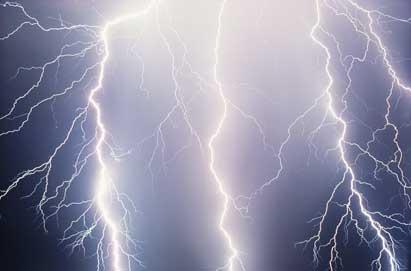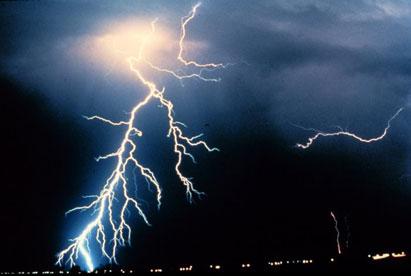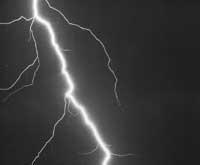Lightning: 150 million volt electric discharge
2001/03/25 Astobiza, Amaia
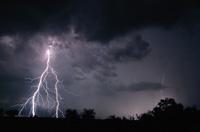
In the days of thunderstorms, we can say that clouds act as huge capacitors. Capacitors are instruments formed by two conductive sheets. Among these plates is a dielectric, that is, an electrical insulator. Applying tension, negative loads accumulate on one sheet and positive ones on the other. This creates an electric field between the two plates where electricity can be stored. As has been said, clouds also act similarly. For the reasons we will explain later, the top of the clouds becomes positive and the bottom becomes negative.
But to better understand the processes that occur inside the clouds, let us remember the sargoric days of summer. In these cases, the air humidity is evident and the land surface is very hot. Therefore, the air near the ground is heated and expanded easily, decreasing density and moving the air up. In the ascent two phenomena occur together. On the one hand, the air cools because it moves away from the heat from the ground. On the other hand, the increase in altitude, coupled with lower atmospheric pressure, makes the air spread more, which also helps cooling.
At a time of this cooling process, air is no longer able to retain so much moisture, so water condenses and fog forms. In this steam condensation process heat is released, so the cloud still rises faster and increases a lot. Also, the higher the cloud, the lower the temperature at the top of the cloud. When it reaches -10 and -20 C, the cloud's water vapor sublimates into ice crystals. So, at that time, at the bottom of the cloud we have the drops of water and the pieces of ice at the top.
But the water drops generated are very small and do not precipitate by themselves. Due to turbulence in the air, water drops and ice crystals are touched. Gradually ice crystals increase and begin to fall. When falling, the temperature of the crystals increases. When you reach zone 0 C the crystals melt and then yes, it is time to take out the umbrella or seek refuge in the ramp. However, water droplets generated by melting crystals may be captured by another turbulence and returned to the top. The formation of ice crystals of a certain magnitude in this upper part will precipitate like hail. But from these facts, how do rays occur? How does the aforementioned energy transfer occur? There are several theories that try to explain this phenomenon. We, here, will explain the most widespread and accepted.
As we have said before, turbulence causes ice crystals and water drops to collide and merge. But that is not always so and there are some who stick but don't join. Instead, electrons are released from the rising humidity. The released electrons accumulate at the bottom of the cloud, so this part of the cloud is negatively charged. Rising humidity, by losing electrons, has a positive charge. Therefore, the top of the cloud is positively loaded. As the temperature at the top is lower, the top of the cloud freezes into positively charged pieces of ice.
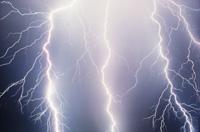
Impacts and freezing are constant, so at the bottom of the cloud there are more and more negative loads and the intensity of the electric field is higher. Finally, the negative charge at the bottom of the clouds is so great that it repels the negative loads of the Earth's surface. Consequently, the surface of the earth is positively charged. Now, the only thing necessary for energy transfer to occur is a path that serves as a bridge between fog and earth. The one who plays this role is the air surrounding the cloud. But for this it is necessary to ionize air. And how does that happen?
First, the conductive part of the negatively charged cloud approaches the ground and attracts positive soil loads. On Earth, positive burdens are in thousands of places. For example, pine needles or short grass leaves. All these positive charges are joined at the end of the driver, that is, the terrestrial object is also ionized. In the end, the potential difference between cloud and earth is so great that the air surrounding the cloud is somehow broken, ionized. The current then spreads through the air to neutralize the distribution of loads. In other words, this short-circuited air break between the cloud and the earth as if there were a metallic wire between the two.
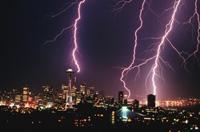
But before this drastic discharge occurs a series of much less energetic discharges that mark the path traveled by the main beam. The phenomenon therefore begins with a small spark. This spark makes discontinuous air jumps in search of less resistant regions. If at one point they encounter two or more unresistant regions, the initial spark branches and its branches continue to spread along the simplest possible path. In most cases, before these sparks reach the ground, by some nearby peak (buildings, trees, etc.) other sparks come out and correspond to those coming from the clouds. At that time the greatest discharge occurs. And this download is also a series of downloads separated by a tenth of a second and whose number can reach 40.
The propagation speed of air discharge may vary between 30,000 and 160,000 km/s. When it happens, the air warms so much that in the end it gives a lot of light. And look, the ray! have you seen it? But the lightning never comes in silence. As the air spreads so sharply, a pressure wave is created that produces thunder. To us, when we listen, it seems to us that it grazes and repeats itself, because we perceive the noise that we hear more and more close to the base of the cloud. In addition, this noise is confused with the echo produced by natural and artificial barriers. But, quiet, it's just an electric shock of about 150 million volts!
The lightning will not catch you!
Lightning is observed when positive or negative charge transfer occurs. This transfer can be from one side to the other of the cloud, between clouds or between cloud and earth. However, the most harmful rays are those that occur between clouds and earth. The most common are those of negative charge, around 90%.
On the contrary, positive load rays are rare and occur mostly at the end of the storm. However, they are more dangerous than those of negative charge. This is because the air currents generated are double and therefore last longer. This causes burns and considerably increases the temperature of objects affected by lightning.
In general, the tension needed to ionize the air and produce lightning is about 300,000 volts per meter. That is, if the cloud is 500 meters from the ground, the potential difference for lightning to occur must be around 150 million volts. Moreover, the intensity of this short current can vary between 10,000 and 500,000 amps.
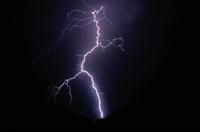
The lightning light, if you are attentive, we see it immediately after its formation, as it propagates at an approximate speed of 300,000 km/s. Thunder propagation speed is relatively low, around 340 m/s. Measuring the time elapsed since we have seen the lightning until we have heard the thunder, we can calculate the approximate distance to the lightning drop point.
For this we only have to multiply the seconds passed by 340. But, look! that the rain will not wait for you! Just in case, know that raindrops that will leave you melancholy after the electric shock fall at a speed of 6-7 m/s.
In addition, if possible, it is ideal to enter the house or inside the car and observe the beauty of the rays from the other side of the glass. In any case, do not try to protect yourself under the bridge, as trees attract lightning. The most important thing is that contact with the earth is as little as possible and that the body is as low as possible, so if a lightning strikes near you, the electric current will cost to pass through your body.
Published in the supplement Natura de Gara

Gai honi buruzko eduki gehiago
Elhuyarrek garatutako teknologia



